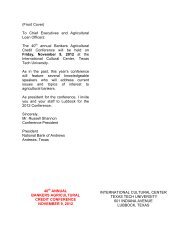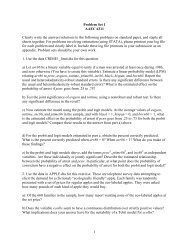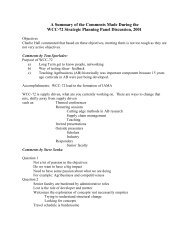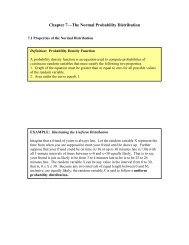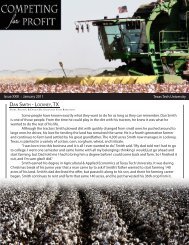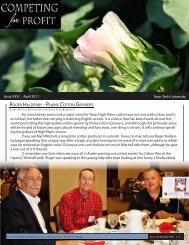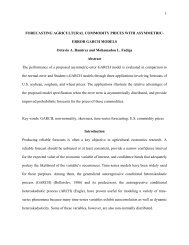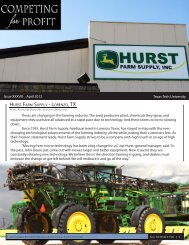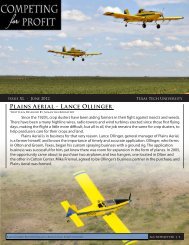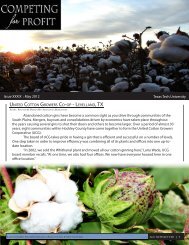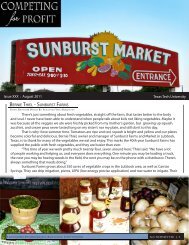Brad Heffington - Texas Tech University
Brad Heffington - Texas Tech University
Brad Heffington - Texas Tech University
You also want an ePaper? Increase the reach of your titles
YUMPU automatically turns print PDFs into web optimized ePapers that Google loves.
ACC NEWSLETTER | 2<br />
Larry Combest Endowed Chair in Agricultur al Competitiveness<br />
acknowledges that dealing with the weather is<br />
a major part of a farmer’s business, and so he<br />
will take it as it comes.<br />
<strong>Heffington</strong> said although bad years<br />
come along with the good, he remains thankful<br />
that in 1989 a small town banker took a chance<br />
on him, which allowed him to do what he continues<br />
to love today, farm.<br />
“I was a junior at <strong>Texas</strong> <strong>Tech</strong> when some<br />
land became available for me to farm,” <strong>Heffington</strong><br />
said. “I tried to get a loan from several<br />
places with no luck. Mr. Lee decided to take a<br />
shot on me, and I am sure glad he did.”<br />
James Lee, of the First National Bank of<br />
Littlefield, must have seen a drive in <strong>Heffington</strong><br />
that has continued to grow and prosper to this<br />
very day. Besides striving to learn and remain<br />
educated on seed, fertilizer, and equipment,<br />
<strong>Heffington</strong> has worked hard to gain knowledge<br />
about the marketing side of his operation.<br />
<strong>Heffington</strong>, who graduated from <strong>Texas</strong><br />
<strong>Tech</strong> <strong>University</strong> with a Bachelor’s of Business<br />
Administration and from the <strong>Texas</strong> A&M<br />
Master Marketer program, uses technical and<br />
fundamental analysis, and stays in tune with<br />
local and world markets. He said being able to<br />
market his cotton has earned him income and<br />
success. He went on to say marketing is a very<br />
important aspect of his business, and he tries to<br />
take advantage of every opportunity he can to<br />
capture the best prices for his cotton.<br />
<strong>Heffington</strong> earned an average selling<br />
price of $1.08 on his cotton last year, selling<br />
some towards the end for $1.50. He said everything<br />
kept falling in place for him as he grew<br />
and sold his cotton. Rain came pretty steadily,<br />
and prices rose. And although the growing<br />
season may not be as favorable this year as last,<br />
<strong>Heffington</strong> said he continues to see prices staying<br />
strong.<br />
“If crops remain as dry as they are now,<br />
dryland acres may not be there and our irrigated<br />
production is liable to decrease, which<br />
means prices this fall could stay up,” <strong>Heffington</strong><br />
said. “However, those high prices won’t do<br />
much good if we don’t have cotton to sell.”<br />
<strong>Heffington</strong> said with the rising input<br />
costs farmers have to deal with, they cannot<br />
stand to sell cotton for 60 to 70 cents anymore.<br />
Seed, fuel, labor, fertilizer, equipment, technology,<br />
they have all gotten significantly more<br />
expensive in a short amount of time, making<br />
every cent count to the farmer.<br />
“In order to be successful in farming you<br />
must figure out what pays and what doesn’t,”<br />
<strong>Heffington</strong> said. “Some technology may cost<br />
Andy Timmons planting grapes.



